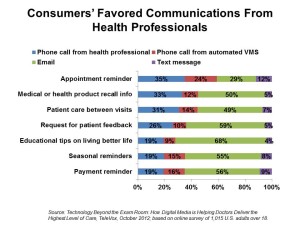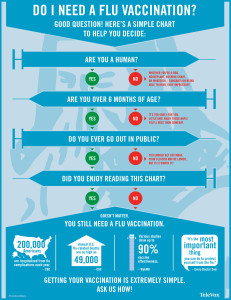 85% of U.S. health consumers say that emails, text messages, and voicemails are at least as helpful as in-person or phone conversations with health providers, according to the TeleVox Healthy World study, Technology Beyond the Exam Room. The study was based on surveys conducted with over 2,200 health providers across specialties, and 1,015 U.S. adults over 18.
85% of U.S. health consumers say that emails, text messages, and voicemails are at least as helpful as in-person or phone conversations with health providers, according to the TeleVox Healthy World study, Technology Beyond the Exam Room. The study was based on surveys conducted with over 2,200 health providers across specialties, and 1,015 U.S. adults over 18.
Furthermore, one in 3 consumers admit to being more honest when talking about medical needs via automated voice response systems, emails or texts than face-to-face with a health provider.
And 3 in 10 consumers believe that receiving digital health communications from providers such as texts, voicemails or emails that provide patient care would build trust with their providers. 51% say they’d feel more valued as a patient via digital health communications.
 The chart illustrates various communications messaging that consumers value via various digital channels. The red bar represents email: clearly, email is a valued channel across nearly all message types surveyed, from patient care (49%) and health tips (68%) to seasonal reminders (55%, THINK: flu shots, illustrated in the second infographic from TeleVox) and payment reminders (56%).
The chart illustrates various communications messaging that consumers value via various digital channels. The red bar represents email: clearly, email is a valued channel across nearly all message types surveyed, from patient care (49%) and health tips (68%) to seasonal reminders (55%, THINK: flu shots, illustrated in the second infographic from TeleVox) and payment reminders (56%).
All consumers, from Gen X and Gen Y to Baby Boomers, look for these messages to be personally tailored, welcoming in the era of personalized medicine via digital communications.
Health Populi’s Hot Points: Patients are educating themselves to be health consumers in the emerging healthcareDIY era. While payers and providers should be doing a better job preparing people to play this role, the education is largely done by people themselves. Consumers’ demands for digitally-delivered health services are central to this education, which nurtures empowerment and trust, as people pointed out in the TeleVox survey.
That 1 in 2 consumers (49%) say they’re open to receiving medical care between visits via email testifies to consumers’ demand for telehealth services. If payment can align between payers, providers and consumers to marshall distance health services to the home and workplace, we’ll be building a more satisfied, empowered, and healthy patient. Value-based and accountable care can help get us to this Patient 2.0.




 I love sharing perspectives on what's shaping the future of health care, and appreciate the opportunity to be collaborating once again with Duke Corporate Education and a global client on 6th May. We'll be addressing some key pillars to consider in scenario planning such as growing consumerism in health care, technology (from AI to telehealth), climate change, and trust -- the key enabler for health engagement or dis-engagement and mis-information. I'm grateful to be affiliated with the corporate education provider
I love sharing perspectives on what's shaping the future of health care, and appreciate the opportunity to be collaborating once again with Duke Corporate Education and a global client on 6th May. We'll be addressing some key pillars to consider in scenario planning such as growing consumerism in health care, technology (from AI to telehealth), climate change, and trust -- the key enabler for health engagement or dis-engagement and mis-information. I'm grateful to be affiliated with the corporate education provider  Thank you FeedSpot for
Thank you FeedSpot for